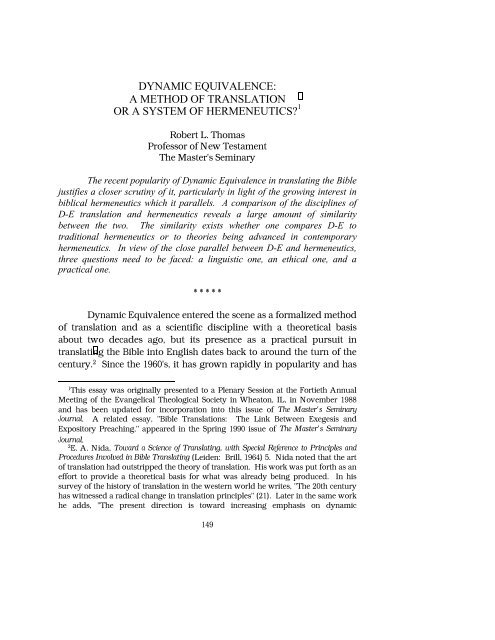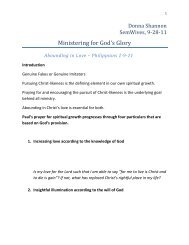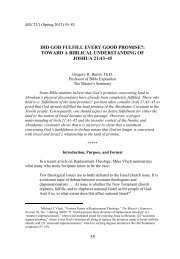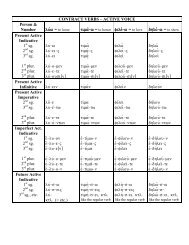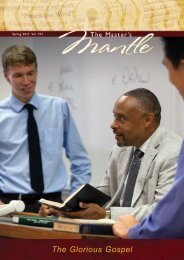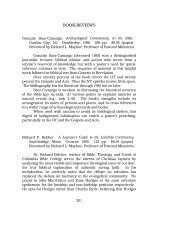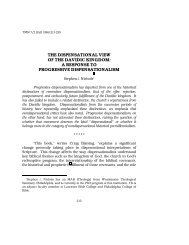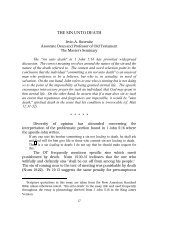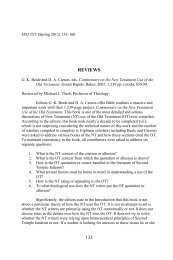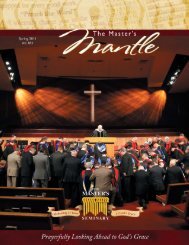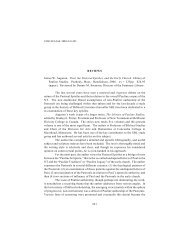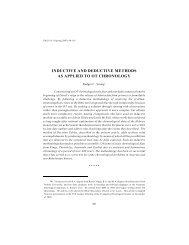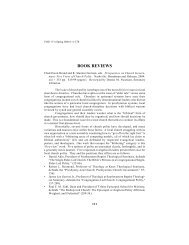dynamic equivalence: a method of translation or a system
dynamic equivalence: a method of translation or a system
dynamic equivalence: a method of translation or a system
- No tags were found...
You also want an ePaper? Increase the reach of your titles
YUMPU automatically turns print PDFs into web optimized ePapers that Google loves.
DYNAMIC EQUIVALENCE:A METHOD OF TRANSLATIONOR A SYSTEM OF HERMENEUTICS? 1Robert L. ThomasPr<strong>of</strong>ess<strong>or</strong> <strong>of</strong> New TestamentThe Master's SeminaryThe recent popularity <strong>of</strong> Dynamic Equivalence in translating the Biblejustifies a closer scrutiny <strong>of</strong> it, particularly in light <strong>of</strong> the growing interest inbiblical hermeneutics which it parallels. A comparison <strong>of</strong> the disciplines <strong>of</strong>D-E <strong>translation</strong> and hermeneutics reveals a large amount <strong>of</strong> similaritybetween the two. The similarity exists whether one compares D-E totraditional hermeneutics <strong>or</strong> to the<strong>or</strong>ies being advanced in contemp<strong>or</strong>aryhermeneutics. In view <strong>of</strong> the close parallel between D-E and hermeneutics,three questions need to be faced: a linguistic one, an ethical one, and apractical one.* * * * *Dynamic Equivalence entered the scene as a f<strong>or</strong>malized <strong>method</strong><strong>of</strong> <strong>translation</strong> and as a scientific discipline with a the<strong>or</strong>etical basisabout two decades ago, but its presence as a practical pursuit intranslating the Bible into English dates back to around the turn <strong>of</strong> thecentury. 2 Since the 1960's, it has grown rapidly in popularity and has1This essay was <strong>or</strong>iginally presented to a Plenary Session at the F<strong>or</strong>tieth AnnualMeeting <strong>of</strong> the Evangelical Theological Society in Wheaton, IL, in November 1988and has been updated f<strong>or</strong> inc<strong>or</strong>p<strong>or</strong>ation into this issue <strong>of</strong> The Master's SeminaryJournal. A related essay, "Bible Translations: The Link Between Exegesis andExposit<strong>or</strong>y Preaching," appeared in the Spring 1990 issue <strong>of</strong> The Master's SeminaryJournal.2E. A. Nida, Toward a Science <strong>of</strong> Translating, with Special Reference to Principles andProcedures Involved in Bible Translating (Leiden: Brill, 1964) 5. Nida noted that the art<strong>of</strong> <strong>translation</strong> had outstripped the the<strong>or</strong>y <strong>of</strong> <strong>translation</strong>. His w<strong>or</strong>k was put f<strong>or</strong>th as aneff<strong>or</strong>t to provide a the<strong>or</strong>etical basis f<strong>or</strong> what was already being produced. In hissurvey <strong>of</strong> the hist<strong>or</strong>y <strong>of</strong> <strong>translation</strong> in the western w<strong>or</strong>ld he writes, "The 20th centuryhas witnessed a radical change in <strong>translation</strong> principles" (21). Later in the same w<strong>or</strong>khe adds, "The present direction is toward increasing emphasis on <strong>dynamic</strong>149
principles as a part <strong>of</strong> its <strong>translation</strong> <strong>method</strong> and to weigh whether itshould be termed a <strong>method</strong> <strong>of</strong> <strong>translation</strong> <strong>or</strong> a <strong>system</strong> <strong>of</strong> hermeneutics.Eugene A. Nida, who probably has earned the title <strong>of</strong> "the father <strong>of</strong><strong>dynamic</strong> equiva-lence," though he m<strong>or</strong>e recently has chosen to call theprocess "functional <strong>equivalence</strong>," 4 sees hermeneutics as entirelyseparate from <strong>dynamic</strong>-<strong>equivalence</strong> <strong>translation</strong> procedures, 5 but doesso on the basis <strong>of</strong> a novel understanding <strong>of</strong> hermeneutics. He definesthe field <strong>of</strong> hermeneutics as that which points out parallels betweenthe biblical message and present-day events and determines the extent<strong>of</strong> relevance and the appropriate response f<strong>or</strong> the believer. 64J. de Waard and E. A. Nida, From One Language to Another, Functional Equivalencein Bible Translating (Nashville: Nelson, 1986) vii-viii. The auth<strong>or</strong>s mean nothingdifferent from what Nida intended by "<strong>dynamic</strong> <strong>equivalence</strong>" in his Toward a Science<strong>of</strong> Translating, but have opted f<strong>or</strong> the new terminology because <strong>of</strong> a misunderstanding<strong>of</strong> the older expression and because <strong>of</strong> abuses <strong>of</strong> the principle <strong>of</strong> <strong>dynamic</strong> <strong>equivalence</strong>by some translat<strong>or</strong>s.5E. A. Nida and W. D. Reyburn, Meaning Across Culture (Maryknoll, NY: Orbis,1981) 30.6Ibid.151
152 The Master's Seminary JournalThis concept <strong>of</strong> hermeneutics is quite different from that tradi-tionally assignedto the w<strong>or</strong>d. N<strong>or</strong>mally it is defined as "the science <strong>of</strong> interpretation." 7 Webster'sNew Collegiate Dictionary defines hermeneu-tics as "the study <strong>of</strong> the <strong>method</strong>ologicalprinciples <strong>of</strong> interpretation." 8 Webster's New Twentieth Century Dictionary Unabridgedmakes herme-neutics synonymous with exegesis. 9 Terry m<strong>or</strong>e precisely notes thathermeneutics constitutes the principles <strong>of</strong> interpretation that are applied byexegesis. 10 Yet Nida emphatically distinguishes between exegesis andhermeneutics, and says they are two distinct components <strong>of</strong> the larger categ<strong>or</strong>y <strong>of</strong>interpretation. 11Admittedly the connotation <strong>of</strong> "hermeneutics" has shifted in recent times, 12creating widespread confusion. Yet Nida appears to be in disharmony witheveryone in his definition. He has equated hermeneutics with what hastraditionally been called "application," which is based on the one c<strong>or</strong>rectinterpretation <strong>of</strong> the <strong>or</strong>iginal writing, 13 and in so doing, has represented anextreme position that is unacceptable because it represents an abn<strong>or</strong>mal sense <strong>of</strong>the w<strong>or</strong>d. So his strict dissociation <strong>of</strong> hermeneutics and <strong>translation</strong> cannot betaken seriously.In light <strong>of</strong> current confusion over the scope <strong>of</strong> hermeneutics we must stipulateour meaning <strong>of</strong> the term in the context <strong>of</strong> this investigation. In the earlier part <strong>of</strong>the discussion we will focus on "the m<strong>or</strong>e technical kind <strong>of</strong> hermeneutics known assacred <strong>or</strong> biblical hermeneutics," 14 in other w<strong>or</strong>ds, the traditional definition. Laterwe will expand to include m<strong>or</strong>e recent elements which have in some circles foundtheir way under the broadened umbrella <strong>of</strong> "hermeneutics."7M. S. Terry, Biblical Hermeneutics (Grand Rapids: Zondervan, n.d.) 17. H. A. Virkler,Hermeneutics`Principles and Processes <strong>of</strong> Biblical Interpretation (Grand Rapids: Baker, 1981) 16, callshermeneutics "the science and art <strong>of</strong> biblical interpretation." D. F. Ferguson, Biblical Hermeneutics, anIntroduction (Atlanta: John Knox, 1986) 4, views the traditional definition <strong>of</strong> hermeneutics as the"study <strong>of</strong> the locus and principles <strong>of</strong> interpretation."8Webster's New Collegiate Dictionary (Springfield, Mass.: G. & C. Merriam, 1983) 536.9Webster's New Twentieth Century Dictionary <strong>of</strong> the English Language Unabridged (New Y<strong>or</strong>k: Simonand Schuster, 1979) 851. Webster's Third New International Dictionary <strong>of</strong> the English LanguageUnabridged (Springfield, Mass.: G. & C. Merriam, 1971) 1059, defines hermeneutics as follows: "thestudy <strong>of</strong> the <strong>method</strong>o-logical principles <strong>of</strong> interpretation and explanation; specif.: the study <strong>of</strong> thegeneral principles <strong>of</strong> biblical interpretation."10Terry, Biblical Hermeneutics 19.11Nida and Reyburn, Meaning 30. See also de Waard and Nida, From One Language 40, where theauth<strong>or</strong>s write, "This issue <strong>of</strong> the communicative role <strong>of</strong> the Bible highlights an imp<strong>or</strong>tant distinctionwhich may be made between exegesis and hermeneutics, although some writers use these termsalmost indistinguishably."12B. L. Ramm and others, Hermeneutics (Grand Rapids: Baker, 1987) 6. Ramm writes, "Althoughtraditionally hermeneutics has been treated as a special theological discipline, recent studies haveendeav<strong>or</strong>ed to enlarge the scope <strong>of</strong> hermeneutics. These studies wish to see hermeneutics in a widerperspective as a function <strong>of</strong> the human understanding . . ." (6). Ferguson notes that the traditionaldefinition "needs amplification and qualification since there has been a steady shifting <strong>of</strong> emphasesin carrying out the hermeneutical task . . ." (Biblical Hermeneutics 4).13Terry, Biblical Hermeneutics 600.14Ramm, Hermeneutics 6.
Dynamic Equivalence . . . 153DYNAMIC EQUIVALENCEAND TRADITIONAL HERMENEUTICSThe Overlapping <strong>of</strong> Dynamic Equivalence and ExegesisOne <strong>of</strong> the striking features <strong>of</strong> <strong>dynamic</strong> <strong>equivalence</strong> is its embracing withinits <strong>method</strong>ology <strong>of</strong> what has been known traditionally as biblical exegesis.Inclusion <strong>of</strong> exegetical procedures is necessitated by the first <strong>of</strong> three steps that<strong>dynamic</strong>-<strong>equivalence</strong> the<strong>or</strong>y recommends. The three steps are reduction <strong>of</strong> thesource text to its structurally simplest and most semantically evident kernels,transference <strong>of</strong> the meaning from the source language to the recept<strong>or</strong> language ona structurally simple level, and generation <strong>of</strong> the stylistically and semanticallyequivalent expression in the recept<strong>or</strong> language. 15The first <strong>of</strong> the three steps consists <strong>of</strong> two parts, analysis <strong>of</strong> the source text interms <strong>of</strong> grammatical relationships and analysis <strong>of</strong> it in terms <strong>of</strong> the meanings <strong>of</strong>the w<strong>or</strong>ds and combinations <strong>of</strong> w<strong>or</strong>ds. 16 A common way to illustrate grammaticalanalysis is with uses <strong>of</strong> the Greek genitive case and the c<strong>or</strong>responding Englishconstruction <strong>of</strong> two nouns <strong>or</strong> pronouns connected by "<strong>of</strong>." 17 Those familiar withthe earliest stages <strong>of</strong> NT Greek study recognize quickly that an analysis <strong>of</strong> thevarious uses <strong>of</strong> the Greek genitive case is a standard part <strong>of</strong> preparation f<strong>or</strong> biblicalexegesis. Yet there is a strange reticence by those who espouse D-E <strong>method</strong>ologyto recognize that this type <strong>of</strong> study has been underway f<strong>or</strong> a long time. 18The 1986 w<strong>or</strong>k by de Waard and Nida does refer to standard tools <strong>of</strong>lexicography, but it casts them in a negative light. Traditional bilingualdictionaries are labeled as deficient because they depend almost entirely on15Nida, Toward a Science 68. Acc<strong>or</strong>ding to Nida, this three-step process is the way "the reallycompetent translat<strong>or</strong>" w<strong>or</strong>ks.16E. A. Nida and C. R. Taber, The The<strong>or</strong>y and Practice <strong>of</strong> Translation (Leiden: E. J. Brill, 1969) 33.17Nida, Toward a Science 207-208, 229; Nida and Taber, The The<strong>or</strong>y 35-37. "Field <strong>of</strong> blood" (Acts1:19) and "God <strong>of</strong> peace" (Phil 4:9) are two among the suggested examples <strong>of</strong> ambiguity (Nida, 229).F<strong>or</strong> the f<strong>or</strong>mer Nida suggests two possible interpretations, "field where blood was spilled" (<strong>or</strong>"shed") <strong>or</strong> "field that reminded people <strong>of</strong> blood." F<strong>or</strong> the latter he rejects "a peaceful God" as anoption, and chooses "God who gives peace" <strong>or</strong> "God who causes peace."18The sole use <strong>of</strong> "exegesis" in the index <strong>of</strong> Nida's Toward a Science <strong>of</strong> Translating is in a passingreference to the field in his hist<strong>or</strong>ical survey <strong>of</strong> <strong>translation</strong>s in the western w<strong>or</strong>ld (Nida, Toward aScience 28). The only place where Nida and Taber use "exegesis" in their The<strong>or</strong>y and Practice <strong>of</strong>Translation, acc<strong>or</strong>ding to their index, is as a part <strong>of</strong> a sample set <strong>of</strong> principles prepared f<strong>or</strong> use inmaking a "Southern Bantu" <strong>translation</strong>, and this mention is only in passing (Nida and Taber, TheThe<strong>or</strong>y 182). The standard grammars f<strong>or</strong> NT Greek are never alluded to in the above w<strong>or</strong>ks, n<strong>or</strong> arethey listed in their bibliographies.This coolness toward what has been a long established field <strong>of</strong> biblical studies is perhaps reflectedin the judgment <strong>of</strong> Nida and others that good exegetes and grammarians make po<strong>or</strong> translat<strong>or</strong>s (E.A. Nida, "Bible Translation f<strong>or</strong> the Eighties," International Review <strong>of</strong> Mission 70 [1981] 136-137). H. H.Hess, "Some Assumptions," a paper read at the President's Luncheon, Biola University, Nov 15,1984, 9, states as his ninth assumption "that the linguistic and cultural demands <strong>of</strong> non-Indo-European languages necessitate biblical interpretation that goes beyond traditional andconventional exegesis." This assumption <strong>of</strong> a Wycliffe Bible translat<strong>or</strong> displays the samedissatisfaction with traditional exegesis as Nida and his associates seem to entertain.
154 The Master's Seminary Journal"glosses," i.e. surface structure transfer <strong>of</strong> meanings. 19 The same auth<strong>or</strong>s criticizeBauer-Arndt-Gingrich-Danker f<strong>or</strong> being very un<strong>system</strong>atic and in failing to coverthe ranges <strong>of</strong> meaning <strong>of</strong> individual w<strong>or</strong>ds. 20 It is evident from these criticismsthat the analysis step in the D-E process covers the same ground that hastraditionally been covered by exegesis, an exegesis based on principles <strong>of</strong>interpretation that compose the field <strong>of</strong> hermeneutics. 21From the perspective <strong>of</strong> a traditional definition <strong>of</strong> hermeneutics little doubtcan be entertained that D-E is, among other things, a <strong>system</strong> <strong>of</strong> hermeneutics.Perhaps some will respond, however, that all <strong>translation</strong>s are commentaries andhence inc<strong>or</strong>p<strong>or</strong>ate the application <strong>of</strong> hermeneutical principles in arriving at theirrenderings. This is absolutely true. 22 A certain degree <strong>of</strong> interpretation isunavoidable, no matter how hard the translat<strong>or</strong> tries to exclude it. Yet acharacteristic <strong>of</strong> f<strong>or</strong>mal <strong>equivalence</strong> is its eff<strong>or</strong>t to avoid interpretation as much aspossible by transferring directly from the surface structure <strong>of</strong> the source languageto the surface structure <strong>of</strong> the recept<strong>or</strong> language. 23 By omitting the step <strong>of</strong> analysisthat is built into the D-E approach, interpretation can be excluded to a much higherdegree. Since D-E intentionally inc<strong>or</strong>p<strong>or</strong>ates interpretation, it obviously has asignificantly higher degree <strong>of</strong> interpretation than f<strong>or</strong>mal <strong>equivalence</strong> and is in amuch stronger sense a <strong>system</strong> <strong>of</strong> hermeneutics than is f<strong>or</strong>mal <strong>equivalence</strong>.Dynamic Equivalence and Ambiguous PassagesOne type <strong>of</strong> passage illustrates particularly well the commitment <strong>of</strong><strong>dynamic</strong> <strong>equivalence</strong> to the practice <strong>of</strong> hermeneutics. This is a passage whoseinterpretation is uncertain, i.e. one whose meaning is ambiguous. As a generalrule, <strong>dynamic</strong> <strong>equivalence</strong> is dedicated to the elimination <strong>of</strong> ambiguities.In building his rationale f<strong>or</strong> D-E, Nida quotes Alexander Fraser Tytler's19de Waard and Nida, From One Language 160.20Ibid., 161-62.21Further evidence <strong>of</strong> the inclusion <strong>of</strong> hermeneutics in the D-E <strong>method</strong>ology is seen in what D-Eauth<strong>or</strong>s have written about such things as how to handle the synonyms gapv (agapa, "I love") and filv(phile, "I love") in John 21:15-19 (de Waard and Nida, From One Language 93), the treatment <strong>of</strong>anacolutha (ibid., 105), the meaning <strong>of</strong> katalambnv (katalamban, "I apprehend") in John 1:5 (ibid.,107), and the meaning <strong>of</strong> martyra 1Ihso (martyria Isou, "the testimony <strong>of</strong> Jesus") in Revelation 1:2(ibid., 127). All these belong properly in the realm <strong>of</strong> exegesis. As a matter <strong>of</strong> fact, de Waard andNida in essence acknowledge the essential presence <strong>of</strong> the science <strong>of</strong> interpretation in D-E when theywrite, "The primary exegetical perspective <strong>of</strong> a translat<strong>or</strong> is `what did the text mean to the peoplewho were the <strong>or</strong>iginal recept<strong>or</strong>s?'" (ibid., 177).Glassman gives a similar but simpler explanation <strong>of</strong> the step <strong>of</strong> analysis, using srj (sarx,"flesh") with its varying NT meanings as one <strong>of</strong> his examples <strong>of</strong> the interpretive decisions whichmust be made by a D-E translat<strong>or</strong> (Glassman, Trans-lation Debate 59-60).22D. G. Rossetti expressed this over a century ago: "A <strong>translation</strong> remains perhaps the most directf<strong>or</strong>m <strong>of</strong> commentary" (cited by Nida, Toward a Science 156).23W. L. Wonderly, Bible Translations f<strong>or</strong> Popular Use (London: United Bible Societies, 1968) 51, callsf<strong>or</strong>mal c<strong>or</strong>respondence, a later name f<strong>or</strong> f<strong>or</strong>mal <strong>equivalence</strong>, "the direct transfer technique." Herefers to <strong>dynamic</strong> <strong>equivalence</strong> as a process <strong>of</strong> "indirect transfer, involving `decomposition andrecomposition' <strong>or</strong> analysis-plus-restructuring" (ibid.).
Dynamic Equivalence . . . 155principle approvingly: "To imitate the obscurity <strong>or</strong> ambiguity <strong>of</strong> the <strong>or</strong>iginal is afault and it is still a greater one to give m<strong>or</strong>e than one meaning." 24 To followthrough with this perspective, he later uses the Greek genitive-case f<strong>or</strong>m with thec<strong>or</strong>responding use <strong>of</strong> the English preposition "<strong>of</strong>" to illustrate how to eliminateambiguities. 25 "Cup <strong>of</strong> the L<strong>or</strong>d" (1 C<strong>or</strong> 10:21) is rendered "the cup by which weremember the L<strong>or</strong>d," "wisdom <strong>of</strong> w<strong>or</strong>ds" (1 C<strong>or</strong> 1:17) is taken to be "well arrangedw<strong>or</strong>ds," and "sons <strong>of</strong> wrath" (Eph 2:3) becomes "those with whom God is angry." 26In each case the obscurity in meaning disappears through a grammaticalrestructuring. 27M<strong>or</strong>e recently, de Waard and Nida have expressed the same perspectiveregarding ambiguous passages: "It is unfair to the <strong>or</strong>iginal writer and to therecept<strong>or</strong>s to reproduce as ambiguities all those passages which may be interpretedin m<strong>or</strong>e than one way." 28 They add that the translat<strong>or</strong> should place in the text thebest attested interpretation and provide in marginal notes the appropriatealternatives. 29Usually the case f<strong>or</strong> non-ambiguity is buttressed by references to theinadequacies <strong>of</strong> f<strong>or</strong>mal-<strong>equivalence</strong> <strong>translation</strong>s. Examples <strong>of</strong> ambiguous andallegedly misleading f<strong>or</strong>mal-<strong>equivalence</strong> <strong>translation</strong>s have been multiplied. Thevolume <strong>of</strong> examples adduced have won the case f<strong>or</strong> D-E in the minds <strong>of</strong> some. 30As persuasive as these lists are, however, superficiality and carelessness havemarked the choices <strong>of</strong> at least some <strong>of</strong> the illustrations. The scope <strong>of</strong> our discussionpermits citation <strong>of</strong> only one widely used passage to illustrate this. In Psalm 1:1Glassman cites the description <strong>of</strong> the "blessed man" who in f<strong>or</strong>mal-<strong>equivalence</strong><strong>translation</strong>s does "not stand in the way <strong>of</strong> sinners." He then criticizes the renderingin these w<strong>or</strong>ds: "Nowadays to stand in the way <strong>of</strong> something <strong>or</strong> someone means to24A. F. Tytler, The Principles <strong>of</strong> Translation (1790), cited by Nida, Toward a Science 19.25Nida, Toward a Science 207-208; cf. also Nida and Taber, The The<strong>or</strong>y 35-37; Wonderly, BibleTranslations 163.26Ibid.27Wonderly in 1968 noted the rarity <strong>of</strong> an expression that is ambiguous when its total context istaken into account (Wonderly, Bible Translations 162). He conversely observed that a completely"unambiguous" expression is also rare (ibid.). In light <strong>of</strong> this he saw the elimination <strong>of</strong> all potentialambiguities as undesirable. Yet, f<strong>or</strong> the sake <strong>of</strong> the uneducated, he advised the translat<strong>or</strong> "toeliminate them <strong>or</strong> reduce to a minimum the probability <strong>of</strong> their being misunder-stood" (ibid., 163).Determination to eliminate ambiguities has seemingly grown stronger with the passage <strong>of</strong>time. In 1981 Nida and Reyburn saw attempts to reproduce ambiguities in a <strong>translation</strong> as unjust tothe <strong>or</strong>iginal auth<strong>or</strong> and unfair to the untrained reader (Nida and Reyburn, Meaning 7-8; ambiguitiesreferred to are, <strong>of</strong> course, those resulting from the scholars' lack <strong>of</strong> understanding, not intentionalambiguities intended by an auth<strong>or</strong>; see also Jean-Claude Margot, "Should a Translation <strong>of</strong> the BibleBe Ambiguous," BT 32/4 [Oct 1981] 406-413). They suggested that the translat<strong>or</strong>'s goal should be totranslate so as to prevent misunderstanding <strong>of</strong> what the <strong>or</strong>iginal recept<strong>or</strong>s understood (ibid., 29).Also in 1981 Glassman gave "avoid ambiguity" as one <strong>of</strong> five guidelines to be followed inc<strong>or</strong>rect <strong>translation</strong>. He displays much less caution in his application <strong>of</strong> this principle than Wonderlydid earlier (Glassman, The Translation Debate 101-4).28de Waard and Nida, From One Language 39.29Ibid.30E.g. Carson, "The Limits" 1.
156 The Master's Seminary Journalprevent <strong>or</strong> hinder, to serve as an obstacle." 31 He should have indicated that thiswas only a personal opinion because his statement is blatantly inaccurateacc<strong>or</strong>ding to auth<strong>or</strong>ities on the English language. Webster's unabridged dictionarygives the following as the first definition <strong>of</strong> the expression "in the way <strong>of</strong>": "so as tomeet <strong>or</strong> fall in with; in a fav<strong>or</strong>able position f<strong>or</strong> doing <strong>or</strong> getting." 32 This is clearlythe c<strong>or</strong>rect idea conveyed by the Hebrew, that <strong>of</strong> "associate with." The blessedman does not place himself in a compromising position with sinners.Unf<strong>or</strong>tunately the reaction <strong>of</strong> Glassman and others against a f<strong>or</strong>mal<strong>equivalence</strong>rendering <strong>of</strong> Psalm 1:1 is characteristic <strong>of</strong> other ill-advised conclusionsby D-E advocates. This is surprising, f<strong>or</strong> some <strong>of</strong> these are leading linguists who asa part <strong>of</strong> their <strong>method</strong>ology advocate a careful respect f<strong>or</strong> the referential meanings<strong>of</strong> w<strong>or</strong>ds and expressions as they appear in dictionary resources. 33 Yet theydisregard their own advice. F<strong>or</strong> example, de Waard and Nida object to f<strong>or</strong>mal<strong>equivalence</strong>renderings <strong>of</strong> Psalm 23:1, "The L<strong>or</strong>d is my shepherd, I shall not want,"by stating flatly, "want no longer means `to lack' but rather `to desire.'" 34 Incontrast, contemp<strong>or</strong>ary dictionaries give the intransitive verb "want" a firstmeaning <strong>of</strong> "lack" <strong>or</strong> "have a need," 35 exactly what the psalmist intended to say. 36Rather than c<strong>or</strong>recting the f<strong>or</strong>mal-<strong>equivalence</strong> translat<strong>or</strong>s, the linguistic specialistsshould have acknowledged the legitimacy <strong>of</strong> their w<strong>or</strong>d choice. They would alsohave been m<strong>or</strong>e credible if they had prefaced their critical remark with "in oursphere <strong>of</strong> knowledge" <strong>or</strong> "acc<strong>or</strong>ding to our judgment," but to say withoutqualification "want no longer means `to lack'" raises questions about their judgmentin general.F<strong>or</strong>mal-<strong>equivalence</strong> <strong>translation</strong>s handle ambiguities in exactly the oppositeway. In the recept<strong>or</strong> rendering they maintain as far as possi-ble the sameambiguity that exists in the source language. This places a heavier responsibilityupon the reader and student <strong>of</strong> the English text by f<strong>or</strong>cing him either to interpretthe passage himself <strong>or</strong> to res<strong>or</strong>t to a commentary <strong>or</strong> Bible teacher <strong>or</strong> exposit<strong>or</strong> f<strong>or</strong>31Glassman, Translation Debate 108. Carson, "The Limits" 5, and de Waard and Nida, From OneLanguage 33, use the same illustration. Glassman is cited because his w<strong>or</strong>k has the earliestpublication date, though he had access to the unpublished manuscript <strong>of</strong> de Waard and Nida(Glassman, Translation Debate 127 [ch 6, n 7]) and may have obtained it from them.32Webster's New Twentieth Century 2071. This same source gives as the first definition <strong>of</strong> "in theway" the idea <strong>of</strong> obstructing, impeding, <strong>or</strong> hindering, but "in the way <strong>of</strong>" is a separate entry (ibid.).Webster's New Collegiate Dictionary, on the other hand, defines "in the way" as meaning, first <strong>of</strong> all, "ina position to be encountered by one: in <strong>or</strong> along one's course" (1325). The idea <strong>of</strong> hindrance <strong>or</strong>obstruction is not introduced until the second definition in this latter source. Similarly, Webster'sThird New International Dictionary defines "in the way" as follows: "on <strong>or</strong> along one's path, road, <strong>or</strong>course: in a position to be encountered by one" (2588).33Nida, Toward a Science 70.34de Waard and Nida, From One Language 9.35Webster's New Twentieth Century 2059. Webster's New Collegiate gives "to be needy <strong>or</strong> destitute"as the first meaning and "to have <strong>or</strong> feel need" as the second (1327). The definition inc<strong>or</strong>p<strong>or</strong>ating theidea <strong>of</strong> "desire" is not given until the fourth definition. After giving an obsolete definition, Webster'sThird New International Dictionary defines "want" by "to be in need" in the first non-obsolete meaning.36Another f<strong>or</strong>mal <strong>equivalence</strong> rendering such as "lack" may be clearer in the minds <strong>of</strong> some than"want," but "want" is still a very legitimate option.
Dynamic Equivalence . . . 157help, but it also leaves open interpretive options that would otherwise be beyondhis reach. 37 It also runs less risk <strong>of</strong> excluding a c<strong>or</strong>rect interpretation.DYNAMIC EQUIVALENCEAND CONTEMPORARY HERMENEUTICSTo compare <strong>dynamic</strong> <strong>equivalence</strong> with contemp<strong>or</strong>ary hermeneutics, it isnecessary to sketch some <strong>of</strong> the recent trends in the latter field.Recent Trends in HermeneuticsOne <strong>of</strong> the recent foci in hermeneutical discussions is the establishment <strong>of</strong> astarting point f<strong>or</strong> interpretation. Special attention to this aspect <strong>of</strong> interpretationfurnishes a convenient approach to comparing D-E with contemp<strong>or</strong>aryhermeneutics.This starting point, sometimes called the interpretive center, functions as acontrol f<strong>or</strong> the interpreter as he attempts to bring together diverse texts <strong>of</strong>Scripture. 38 It serves as the <strong>or</strong>ganizing principle, furnishing the interpretivestructure f<strong>or</strong> exegesis, and is theref<strong>or</strong>e a very imp<strong>or</strong>tant consideration.Eitel p<strong>or</strong>trays two broad types <strong>of</strong> hermeneutical controls, a Scripturedominantone and a context-dominant one. 39 These two are a convenient way todivide the wide ass<strong>or</strong>tment <strong>of</strong> starting points that have been proposed. One groupbelongs to the past and focuses on elements in the <strong>or</strong>iginal settings <strong>of</strong> variousp<strong>or</strong>tions <strong>of</strong> Scripture, and the other belongs to the present with elements <strong>of</strong> thecontemp<strong>or</strong>ary w<strong>or</strong>ld setting the tone f<strong>or</strong> interpretation.Thiselton insists that the starting point must be something in the presentsituation <strong>of</strong> the interpreter. 40 The interpreter addresses his initial questions to thetext and is personally interpreted by the response <strong>of</strong> the text, thus beginning the37J. W. Scott, "Dynamic Equivalence and Some Theological Problems in the NIV," WTJ 48 (Fall1986) 355, points out the superi<strong>or</strong>ity <strong>of</strong> the KJV and NASB renderings <strong>of</strong> Acts 16:31 to that in theNIV, in this regard. Translat<strong>or</strong>s with limited understanding <strong>of</strong> the text, he notes, will m<strong>or</strong>e probablyconvey the <strong>or</strong>iginal meaning m<strong>or</strong>e accurately and m<strong>or</strong>e completely than those <strong>of</strong> a free <strong>or</strong> D-E<strong>translation</strong> (see also p. 351). E. L. Miller, "The New International Version on the Prologue <strong>of</strong> the John,"HTR 72/3-4 (July-Oct 1979) 309, criticizes the NIV f<strong>or</strong> not retaining the ambiguity <strong>of</strong> the Greek in itshandling <strong>of</strong> John 1:9, saying that the translat<strong>or</strong>s had usurped the reader's right to an accuraterendering <strong>of</strong> the text. J. C. Jeske, "Faculty Review <strong>of</strong> the Revised NIV," Wisconsin Lutheran Quarterly85/2 (Spring 1988) 106, cites the same version f<strong>or</strong> its failure to retain the ambiguity <strong>of</strong> the Greek textin Heb 9:14. Yet he also commends the NIV f<strong>or</strong> retaining ambiguity in its handling <strong>of</strong> Luke 17:20(105). A. H. Nichols (in "Explicitness in Translation and the Westernization <strong>of</strong> Scripture," Ref<strong>or</strong>medTheological Review 3 [Sept-Dec 1988] 78-88) calls this focus <strong>of</strong> D-E "explicitness" and pinpoints thedifficulties it creates in <strong>translation</strong>.38D. M. Scholer, "Issues in Biblical Interpretation," EQ LX:1 (Jan 1988) 16.39K. E. Eitel, "Contextualization: Contrasting African Voices," Criswell Theological Review 2:2(Spring 1988) 324.40A. C. Thiselton, "The New Hermeneutic," New Testament Interpretation (Grand Rapids:Eerdmans, 1977) 315.
158 The Master's Seminary Journalhermeneutical circle. 41 Thiselton criticizes the traditional <strong>method</strong> acc<strong>or</strong>ding towhich the interpreter w<strong>or</strong>ks with the text as a passive object, making it his startingpoint. This, he says, is impossible. 42Among others who have joined Thiselton in making something in thepresent a controlling fact<strong>or</strong> in hermeneutics are a number <strong>of</strong> cross-culturalcommunication leaders. Padilla is even m<strong>or</strong>e specific about the necessity <strong>of</strong> aninterpreter's starting from his own situation. 43 Kraft agrees and notes that differentcultural backgrounds produce different needs, which in turn prompt the seeker toask different questions. 44 Because <strong>of</strong> this, he continues, new theologies willeventually emerge in non-Western cultures. Revelation is thus a relative matter,differing in each culture and necessitating that interpretation begin with needsf<strong>or</strong>mulated by the interpreter. 45Marxism as an ideological <strong>system</strong> is the hermeneutical starting point f<strong>or</strong>liberation theology. 46 Another proposed contemp<strong>or</strong>ary starting point inhermeneutics is natural revelation. Mbiti sees natural revelation deposited inAfrican religions as equal in auth<strong>or</strong>ity with and theref<strong>or</strong>e in control <strong>of</strong> biblicalrevelation. 47 Bruce Narram<strong>or</strong>e places natural revelation through secularpsychology on the same level <strong>of</strong> auth<strong>or</strong>ity as biblical revelation and interprets theBible through the eyes <strong>of</strong> secular psychological the<strong>or</strong>y. 48 This list <strong>of</strong> controllingprinciples could be expanded easily. 49The above rapid survey reflects that in the minds <strong>of</strong> many the traditional41Ibid., 316.42Ibid.; A. C. Thiselton, The Two H<strong>or</strong>izons (Grand Rapids: Eerdmans, 1980) 87.43C. R. Padilla, "The Interpreted W<strong>or</strong>d: Reflections on Contextual Hermeneutics," Themelios 7/1(1981) 22.44C. H. Kraft, Christianity in Culture (Maryknoll, NY: Orbis, 1979) 144-46.45Ibid.46Ferguson, Biblical Hermeneutics 177.47J. S. Mbiti, "The Encounter <strong>of</strong> Christian Faith and African Religion," Christian Century 97 (August27 - September 3, 1980) 817-18.48Bruce Narram<strong>or</strong>e, "The Isolation <strong>of</strong> General and Special Revelation as the Fundamental Barrierto the Integration <strong>of</strong> Faith and Learning," paper read at President's Luncheon, Biola University, Oct22, 1984, 2-3, 10.49Some representative writers with a feminist emphasis are explicit about interpretive centerspertaining to their present personal situations. Hull starts with the interpretive guideline thatwomen are fully redeemed and f<strong>or</strong>mulates her biblical interpretations in this light (G. G. Hull,"Response," Women, Auth<strong>or</strong>ity and the Bible [Downers Grove: InterVarsity, 1986] 24). Fi<strong>or</strong>enza's<strong>or</strong>ganizing principle in interpretation is the oppression <strong>of</strong> women by men (Elisabeth SchusslerFi<strong>or</strong>enza, In Mem<strong>or</strong>y <strong>of</strong> Her [New Y<strong>or</strong>k: Crossroad, 1984] 32-33). In light <strong>of</strong> contemp<strong>or</strong>ary socialemphases Jewett and Bilezikian identify Galatians 3:28 as a n<strong>or</strong>m acc<strong>or</strong>ding to which otherScriptures must be interpreted (P. K. Jewett, Man as Male and Female [Grand Rapids: Eerdmans,1975] 142; G. Bilezikian, Beyond Sex Roles [Grand Rapids: Baker, 1985] 128; see also Jerry H. Gill,"Mediated Meaning: A Contextualist Approach to Hermeneutical Method," Asbury TheologicalJournal 43/1 [Spring 1988] 37-38). The conviction that contemp<strong>or</strong>ary experience should be identicalto apostolic Christianity is another principle that will control interpretation (R. Stronstad, "Trends inPentecostal Hermeneutics," Paraclete 22/3 [Summer 1988] 2-3). Other controls that have beensuggested include a decision about whether one can lose his salvation <strong>or</strong> not, a conviction aboutnon-participation in war, and ideas about the capability <strong>of</strong> a believer's never sinning (Scholer,"Issues" 16-17).
Dynamic Equivalence . . . 159starting point in hermeneutics, that <strong>of</strong> the <strong>or</strong>iginal text, is no longer acceptable as acontrol in interpretation, if it ever was. Criticisms <strong>of</strong> the grammatico-hist<strong>or</strong>ical<strong>method</strong> <strong>of</strong> interpretation are <strong>of</strong>ten direct and uninhibited. 50 It is clear that thehermeneutical focus has shifted dramatically from the <strong>or</strong>iginal setting <strong>of</strong> Scriptureto a variety <strong>of</strong> contemp<strong>or</strong>ary issues that have become interpretative controls.Trends in TranslationContemp<strong>or</strong>ary trends in <strong>translation</strong> have paralleled those in hermeneutics.The traditional <strong>method</strong> <strong>of</strong> <strong>translation</strong> adopted the source message as its controland sought to bring the contemp<strong>or</strong>ary reader back to that point. 51 Most recentpreferences in <strong>translation</strong> express the opposite goal, that <strong>of</strong> bringing the sourcemessage into the twentieth century to the contemp<strong>or</strong>ary reader. 52 The new aim isto relate the text to the recept<strong>or</strong> and his modes <strong>of</strong> behavi<strong>or</strong> relevant within thecontext <strong>of</strong> his own culture, a controlling fact<strong>or</strong> called "the principle <strong>of</strong> equivalenteffect." 53 The traditional <strong>method</strong> <strong>of</strong> taking the recept<strong>or</strong> to the text seeks to help thereader identify himself with a person in the source-language context as fully aspossible, teaching him the customs, manner <strong>of</strong> thought, and means <strong>of</strong> expression <strong>of</strong>the earlier time. With D-E, comprehension <strong>of</strong> the patterns <strong>of</strong> the source-languageculture is unnecessary. 54 The prime concern given to effective communication by50E. g. Kraft, Christianity in Culture 131, 136-137; W. S. Las<strong>or</strong>, "The Sensus Pleni<strong>or</strong> and BiblicalInterpretation," Scripture, Tradition, and Interpretation (Grand Rapids: Eerdmans, 1978) 266; see alsoScholer, "Issues" 9.51Nida, Toward a Science 165.52Ibid., 166; Glassman, Translation Debate 74; H. M Wolf, "When `Literal' Is Not Accurate," TheNIV`The Making <strong>of</strong> a Contemp<strong>or</strong>ary Translation (Grand Rapids: Zondervan, 1986) 127. Jerome's LatinVulgate has <strong>of</strong>ten been used as an early example <strong>of</strong> <strong>dynamic</strong> <strong>equivalence</strong> <strong>or</strong> idiomatic <strong>translation</strong>because Jerome expressed the purpose <strong>of</strong> translating "sense f<strong>or</strong> sense" rather than "w<strong>or</strong>d f<strong>or</strong> w<strong>or</strong>d"(e.g. see Nida, Toward a Science 13; J. Beekman and J. Callow, Translating the W<strong>or</strong>d <strong>of</strong> God [GrandRapids: Zondervan, 1974] 24). This widely used quotation <strong>of</strong> Jerome is wrongly used, however,because Jerome adds an imp<strong>or</strong>tant qualification to his statement that is not usually noticed: "exceptf<strong>or</strong> Holy Scripture where even the w<strong>or</strong>d <strong>or</strong>der is sacred" (Epistle LVII, in Jerome: Lettres [ed. JeromeLabourt; Paris, 1953] III, 59, cited by Harvey Mink<strong>of</strong>f, "Problems <strong>of</strong> Translations: Concern f<strong>or</strong> theText Versus Concern f<strong>or</strong> the Reader," Biblical Review 4/4 [Aug 1988] 36). Mysterium, the Latin w<strong>or</strong>drendered "sacred" in this quotation, is rendered "a mystery" by others (Philip Schaff and HenryWace, A Select Library <strong>of</strong> Nicene and Post-Nicene Fathers [Grand Rapids: Eerdmans, 1954] 6:133),because mysterium and sacramentum were used almost interchangeably by the Latin Fathers to referto holy things (A. Dulles, "Mystery in Theology," New Catholic Encyclopedia [Washington: TheCatholic University <strong>of</strong> America, 1967] 10:152). Regardless <strong>of</strong> the English rendering <strong>of</strong> this w<strong>or</strong>d,however, the fact remains that because <strong>of</strong> its inspiration, Jerome put Scripture into a special categ<strong>or</strong>ythat required m<strong>or</strong>e literal <strong>translation</strong> principles than other literature. His Vulgate was theref<strong>or</strong>equite literal (Mink<strong>of</strong>f, "Problems" 36).53Ibid., 159. Mink<strong>of</strong>f describes f<strong>or</strong>mal <strong>equivalence</strong> in different terminology. It produces a "text<strong>or</strong>iented"<strong>or</strong> "overt" <strong>translation</strong> because <strong>of</strong> its persuasion that the meaning lies in the text. D-E on theother hand produces a "reader-<strong>or</strong>iented" <strong>or</strong> "covert" <strong>translation</strong>, assuming that meaning inheres inaudience reaction to the text (Mink<strong>of</strong>f, "Problems" 35).54Ibid.
160 The Master's Seminary JournalD-E at the expense <strong>of</strong> the source is a vivid confirmation <strong>of</strong> this shift in focus. 55These two starting points are quite distinct from each other. F<strong>or</strong>mal<strong>equivalence</strong>and D-E approaches represent two opposite poles in a clash thatsometimes has been labeled "literal <strong>translation</strong>" vs. "free <strong>translation</strong>." 56 To be sure,there are many grades <strong>or</strong> levels between the polar distinctions, 57 but they are polardistinctions. The differing grades between the two poles are traceable to thevarying degrees <strong>of</strong> consistency with which the translat<strong>or</strong>s have adhered to theirstated goals and to self-imposed limitations upon the full implementation <strong>of</strong> D-Eprinciples from passage to passage within the <strong>translation</strong>.An example <strong>of</strong> across-the-board <strong>dynamic</strong> <strong>equivalence</strong> is The Cotton PatchVersion produced by Clarence J<strong>or</strong>dan. It transf<strong>or</strong>ms the source text culturally,hist<strong>or</strong>ically, and linguistically. 58 In this w<strong>or</strong>k Annas and Caiaphas are copresidents<strong>of</strong> the Southern Baptist Convention. Jesus is b<strong>or</strong>n in Gainesville,Ge<strong>or</strong>gia, and lynched rather than being crucified. Most, <strong>of</strong> course, would not pushD-E to that extreme. 59 Yet the w<strong>or</strong>k still illustrates the direction <strong>of</strong> D-E. It showshow the <strong>method</strong>ology is limited only by the judgment <strong>of</strong> the translat<strong>or</strong> <strong>or</strong>translat<strong>or</strong>s. 60Such a release from restraints <strong>of</strong> the <strong>or</strong>iginal text coincides with varyingdegrees <strong>of</strong> subjectivism that characterize contemp<strong>or</strong>ary hermeneutical <strong>system</strong>s.These recent schemes dismiss the traditional <strong>system</strong> <strong>of</strong> letting the auth<strong>or</strong> be thedetermining fact<strong>or</strong> in interpretation. In so doing, <strong>of</strong> necessity they f<strong>or</strong>ce ajudgment <strong>of</strong> the Bible's meaning through the eyes <strong>of</strong> something <strong>or</strong> someonecontemp<strong>or</strong>ary. Hirsch notes that the text has to represent someone's meaning; if itis not the auth<strong>or</strong>'s, then it must be the modern critic's meaning that is drawn fromthe text. 61 Hirsch's terminology distinguishes the auth<strong>or</strong>'s meaning from thecritic's by calling what the auth<strong>or</strong> intended "meaning" and by using the term55D-E does give attention to the source text in its step called "analysis," which is described above.This is not the prime concern <strong>of</strong> D-E, however. In its quest f<strong>or</strong> greater communicative effectiveness,it intentionally omits some inf<strong>or</strong>mation <strong>of</strong> the source text with all its details (see Nida, Toward aScience 224). Perhaps the secondary imp<strong>or</strong>tance <strong>of</strong> the source text and its meaning is reflected also insome <strong>of</strong> Nida's expressions when he injects some <strong>of</strong> his precautionary remarks. CommendingPhillips' <strong>translation</strong> f<strong>or</strong> its high rate <strong>of</strong> decodability, he adds, "Whether Phillips' <strong>translation</strong> <strong>of</strong> thispassage is the best way <strong>of</strong> rendering these difficult verses is not the question at this point" (Nida,Toward a Science 175-76). This could imply that accuracy in meaning is not the maj<strong>or</strong> concern in<strong>translation</strong> (see also 207-8 where a similar idea is expressed). Nichols sees the plight <strong>of</strong> D-E ashopeless because it fails to distinguish between <strong>translation</strong> and communication ("Explicitness" 82-83).56Nida, Toward a Science 22, 171.57Ibid., 24.58Nida and Reyburn, Meaning 19; Glassman, Translation Debate 74. Two <strong>translation</strong>s that aresimilar to The Cotton Patch Version in their across-the-board D-E are God is f<strong>or</strong> Real, Man by Carl F.Burke (1966) and The W<strong>or</strong>d Made Fresh by Andrew Edington (1975) (S. Kubo and W. F. Specht, SoMany Versions? [rev. ed.; Grand Rapids: Zondervan, 1983] 330-33).59Nida, Toward a Science 184.60F<strong>or</strong> example, de Waard and Nida, From One Language 37-39, suggest five situations whenfunctional (i.e. <strong>dynamic</strong>) <strong>equivalence</strong> rather than f<strong>or</strong>mal <strong>equivalence</strong> should be used. Carson, "TheLimits" 5-7, suggests that <strong>equivalence</strong> <strong>of</strong> response be limited to linguistic categ<strong>or</strong>ies alone.61E. D. Hirsch, Jr., Validity in Interpretation (New Haven: Yale University, 1967) 3, 5.
Dynamic Equivalence . . . 161"significance" to refer to a relationship between that meaning and a person,concept, situation, <strong>or</strong> anything else. 62Another way <strong>of</strong> viewing such hermeneutics is by contrasting it with thetraditional hermeneutical distinction between interpretation and application. 63Gill, an advocate <strong>of</strong> a contextualist approach to hermeneutics, says it quite plainly.He supposes that his ment<strong>or</strong> <strong>of</strong> thirty years ago, Pr<strong>of</strong>ess<strong>or</strong> Traina, will disagreewith his contextualist <strong>method</strong> in which there is no longer a distinction betweeninterpretation and application. 64 Application has taken a position as a part <strong>of</strong>interpretation, and in the case <strong>of</strong> J<strong>or</strong>dan's <strong>translation</strong>, it has almost replacedinterpretation completely.While Nida and others call The Cotton Patch Version a <strong>translation</strong>, CharlesKraft calls it a "cultural <strong>translation</strong>" <strong>or</strong> "transculturation," 65 but he also concedesthat <strong>translation</strong> is a limited f<strong>or</strong>m <strong>of</strong> transculturation. 66 He agrees with Nida inadvocating use <strong>of</strong> a "<strong>dynamic</strong>ally equivalent" message to secure a response fromthe modern recipient that is equivalent to the response <strong>of</strong> the <strong>or</strong>iginal recipients <strong>of</strong>the message. Kraft carries <strong>dynamic</strong> <strong>equivalence</strong> beyond transculturation into therealm <strong>of</strong> theologizing, concluding that the latter is a necessary outgrowth <strong>of</strong> thef<strong>or</strong>mer. 67 He inc<strong>or</strong>p<strong>or</strong>ates social custom as so much <strong>of</strong> a controlling fact<strong>or</strong> in<strong>dynamic</strong>-<strong>equivalence</strong> theologizing that matters like the biblical teachings againstpolygamy and in fav<strong>or</strong> <strong>of</strong> monogamous church leadership are negated. 68 This isreminiscent <strong>of</strong> the hermeneutical use <strong>of</strong> natural revelation by Mbiti as an equalauth<strong>or</strong>ity in the interpretation <strong>of</strong> the Bible. 69 Here then is another tie-in betweencontemp<strong>or</strong>ary hermeneutics and <strong>dynamic</strong> <strong>equivalence</strong>.Other Similarities Between Contemp<strong>or</strong>ary Hermeneuticsand Dynamic EquivalenceA similarity in <strong>or</strong>igin. It seems appropriate to point out the similarity insource between recent hermeneutical trends and <strong>dynamic</strong>-<strong>equivalence</strong> techniques.To a large degree, both have <strong>or</strong>iginated in circles that might be labeled as"missiological," "cross-cultural," <strong>or</strong> "biblical linguistic." One only needs to recallsome <strong>of</strong> the prominent names from our earlier discussion <strong>of</strong> hermeneutics to62Ibid., 8.63M. Silva, Has the Church Misread the Bible (Grand Rapids: Zondervan, 1987), pp. 63-67, suggeststhat application is essentially equivalent to alleg<strong>or</strong>ical interpretation. This suggestion is interesting,but it loses sight <strong>of</strong> the fact that alleg<strong>or</strong>ical interpretation as usually understood does not changefrom place to place and period to period as practical application does. Rather it attaches itself to thetext as a deeper <strong>or</strong> hidden meaning that is m<strong>or</strong>e <strong>or</strong> less stable.64Gill, "Mediated Meaning" 40.65Kraft, Christianity in Culture 284-86. Kraft has a narrower definition <strong>of</strong> <strong>translation</strong>: ". . . Thetranslat<strong>or</strong> is not free to provide the degree, extent, and specificity <strong>of</strong> interpretation required toestablish the message solidly in the minds <strong>of</strong> the hearers. N<strong>or</strong> is it within the province <strong>of</strong> a translat<strong>or</strong>to elab<strong>or</strong>ate on the written message to approximate that <strong>of</strong> spoken communication" (280).66Kraft, Christianity in Culture 281.67Ibid., 291.68C. H. Kraft, "Dynamic Equivalence Churches," Missiology 1 (1973) 53-54.69See above p. 15.
162 The Master's Seminary Journalillustrate this. Padilla, Kraft, Mbiti, and others in the listed fields have been in thef<strong>or</strong>efront <strong>of</strong> the contextualization movement that proposes, among other things, arevamping <strong>of</strong> traditional hermeneutical principles. 70 As f<strong>or</strong> <strong>dynamic</strong> <strong>equivalence</strong>in <strong>translation</strong>, Nida notes five influences that have changed <strong>translation</strong> principlesin this century. 71 Two <strong>of</strong> them relate directly to mission <strong>or</strong>ganizations, and theother three are indirectly related to mission activities. Grossman concursregarding the mission-<strong>or</strong>iented <strong>or</strong>igin, giving maj<strong>or</strong> credit to biblical linguists inmissions f<strong>or</strong> the insistence that <strong>translation</strong> be carried out in cultural context as<strong>dynamic</strong> <strong>equivalence</strong> advocates. 72A similarity <strong>of</strong> subjectivity. We have mentioned previously the contextdominantapproach <strong>of</strong> contemp<strong>or</strong>ary hermeneutics, and have noted the highdegree <strong>of</strong> subjectivism promoted thereby. 73 A similar subjectivity prevails in<strong>dynamic</strong> <strong>equivalence</strong>. The potential f<strong>or</strong> interpretational bias is maximized in theD-E approach. 74 F<strong>or</strong>tunately it has not been used <strong>of</strong>ten <strong>or</strong> widely f<strong>or</strong> propagandapurposes, but D-E <strong>translation</strong>s inevitably encounter criticism in various passagesbecause the interpretations chosen in debated passages will always displease some.This problem is not nearly so characteristic <strong>of</strong> f<strong>or</strong>mal-equiv-alence <strong>translation</strong>s.The twelve-year-old New International Version furnishes a good means f<strong>or</strong>illustrating the problem created by subjectivity because, though it is a <strong>dynamic</strong><strong>equivalence</strong><strong>translation</strong>, strict limitations in its application <strong>of</strong> D-E principles havegreatly reduced its deviations from traditional n<strong>or</strong>ms <strong>of</strong> <strong>translation</strong>. 75 In other70To the above list other names involved in cross-cultural fields could be mentioned: L. W.Caldwell (see "Third H<strong>or</strong>izon Ethnohermeneutics: Re-Evaluating New Testament HermeneuticalModels f<strong>or</strong> Intercultural Bible Interpreters Today" [paper presented to Consultation <strong>of</strong>Anthropologists and Theologians, Biola University, April 14-15, 1986] 2), K. Haleblian (see "TheProblem <strong>of</strong> Contextualization," Missiology: An International Review 9/1 [Jan 1983] 99), W. A. Smalley(see "Culture and Superculture," Practical Anthropology 2 [1955] 58-69), S. G. Lingenfelter (see"F<strong>or</strong>mal Logic <strong>or</strong> Practical Logic: Which Should F<strong>or</strong>m the Basis f<strong>or</strong> Cross-Cultural Theology?"[paper presented at the Consultation <strong>of</strong> Anthropologists and Theologians, Biola University, Apr 14-15, 1986] 2, 21), J. M. Bonino (see Doing Theology in a Revolutionary Situation [Philadelphia: F<strong>or</strong>tress,1975] 88-89), and H. M. Conn (see "Contextualization: A New Dimension f<strong>or</strong> Cross-CulturalHermeneutic," Evangelical Missions Quarterly 14 [1978] 44-45).71Nida, Toward a Science 21-22. The five influences are the rapidly expanding field <strong>of</strong> structurallinguistics, the Summer Institute <strong>of</strong> Linguistics (i.e. Wycliffe Bible Translat<strong>or</strong>s), the program <strong>of</strong> theUnited Bible Societies, the publication Babel by the International Federation <strong>of</strong> Translat<strong>or</strong>s, andmachine translat<strong>or</strong>s. The second and third are mission <strong>or</strong>ganizations, and the other three haveimpacted the <strong>method</strong>ology <strong>of</strong> these and other mission <strong>or</strong>ganizations.72Grossman, Translation Debate 73-74, 75-76.73See above pp. 159, 163.74Nida, Toward a Science 184.75Because <strong>of</strong> the nature <strong>of</strong> the limitations observed in producing the NIV, Scott refers to its<strong>method</strong>ology as "moderate `<strong>dynamic</strong> <strong>equivalence</strong>'" (Scott, Dynamic Equivalence 351). J. P. Lewis,"The New International Version," ResQ 24/1 (1981) 6, a member <strong>of</strong> the NIV <strong>translation</strong> team,describes the NIV as a compromise between the traditional and the innovative, as sometimes literaland sometimes <strong>dynamic</strong>ally equivalent. Yet the purpose <strong>of</strong> the NIV as stated in its preface, that <strong>of</strong>representing the meaning rather than producing a w<strong>or</strong>d-f<strong>or</strong>-w<strong>or</strong>d <strong>translation</strong>, places this versionsquarely in the categ<strong>or</strong>y <strong>of</strong> D-E ("Preface," The New International Version Study Bible [Grand Rapids:
Dynamic Equivalence . . . 163w<strong>or</strong>ds, it differs radically from the extreme <strong>dynamic</strong> <strong>equivalence</strong> <strong>of</strong> The CottonPatch Version, f<strong>or</strong> example. Nevertheless, there is and has been a steady stream <strong>of</strong>criticism <strong>of</strong> NIV renderings. A few illustrations will suffice to show this:(1) In 1976 Mare raised questions about the NIV rendering <strong>of</strong> srj (sarx,"flesh") in 1 C<strong>or</strong> 5:5 by "the sinful nature," saying that in this verse it referred to thebody. 76 (2) In 1979 Miller criticized the NIV when it rendered sk-nvsen (esknsen, "hedwelled") in John 1:12 by "lived f<strong>or</strong> a while." This, he said, goes too far in moldingthe reader's interpretation. 77(3) In the same year Scaer objected to 1 Peter 2:8b in the NIV as anillustration <strong>of</strong> how this version is potentially m<strong>or</strong>e insidious than the Living Biblebecause doctrinal problems are less easily recognized. 78 The rendering, he said,supp<strong>or</strong>ted Calvin's doctrine <strong>of</strong> election to damnation.(4) In 1980 Fee objected to the NIV's rendering <strong>of</strong> gynaikw ptesuai (gynaikoshaptesthai, "[good] f<strong>or</strong> a woman not to touch") by "marry" in 1 C<strong>or</strong> 7:1. 79(5) In 1986 Scott criticized the NIV's handling <strong>of</strong> a number <strong>of</strong> passages inActs (i.e. 2:39; 16:34; 18:8) that in the Greek allow f<strong>or</strong> paedobaptism, a possibilitythat is excluded by NIV renderings in these places. 80(6) Earlier this year, Jeske on behalf <strong>of</strong> the faculty <strong>of</strong> Wisconsin LutheranSeminary voiced dissatisfaction with the NIV's rendering <strong>of</strong> Matt 5:32 in both its<strong>or</strong>iginal f<strong>or</strong>m (i.e., "anyone who div<strong>or</strong>ces his wife, except f<strong>or</strong> maritalunfaithfulness, causes her to commit adultery, and anyone who marries a womanso div<strong>or</strong>ced commits adultery") and in its most recently revised f<strong>or</strong>m (i.e., "anyonewho div<strong>or</strong>ces his wife, except f<strong>or</strong> marital unfaithfulness, causes her to become anadulteress, and anyone who marries the div<strong>or</strong>ced woman commits adultery"). 81Zondervan, 1985] xi). Kohlenberger calls the NIV a D-E <strong>translation</strong> (Kohlenberger, W<strong>or</strong>ds 92). Theaccuracy <strong>of</strong> his categ<strong>or</strong>ization is confirmed by the extremely complex <strong>system</strong> <strong>of</strong> symbols andtypefaces used in the exhaustive conc<strong>or</strong>dance that attempts to cross-reference the English <strong>of</strong> that<strong>translation</strong> with w<strong>or</strong>ds <strong>of</strong> the <strong>or</strong>iginal languages (cf. Edward W. Goodrick and John R. KohlenbergerIII, eds., The NIV Exhaustive Conc<strong>or</strong>dance [Grand Rapids: Zondervan, 1990] ix-xxii).76W. H. Mare, "1 C<strong>or</strong>inthians," EBC (Grand Rapids: Zondervan, 1976) 217. In a 1984 revision therendering in the text remains the same, but the NIV committee has added two alternatives: "hisbody" and "the flesh." Mare's suggested c<strong>or</strong>rection is one <strong>of</strong> many found in the Exposit<strong>or</strong>'s BibleCommentary which uses the NIV as its basic text.77Miller, "The New International Version" 309. The committee responded by changing therendering to "made his dwelling" in the 1984 revision.78David P. Scaer, "The New International Version`Nothing New," CTQ 43/1 (June 1979) 242. Thecommittee has not yet changed this rendering. N<strong>or</strong> have they chosen to change the w<strong>or</strong>ds "came tolife" in Rev 20:4. Scaer objected to these w<strong>or</strong>ds because <strong>of</strong> their millennialistic implications.79G. D. Fee, "I C<strong>or</strong>inthians 7:1 in the NIV," JETS 23/4 (1980), 307-314. The committee has not yetinc<strong>or</strong>p<strong>or</strong>ated his suggested literal rendering <strong>of</strong> "touch a woman," but has left the text as it was withan added alternative in the margin which reads "have sexual relations with a woman." In 1990 Feehas gone further and expressed hesitation about D-E in general and the NIV in particular because hefound "far too many absolutely wrong exegetical choices . . . locked into the biblical text as thereader's only option" ("Reflections on Commentary Writing," TToday 46/4 [Jan 1990] 388).80Scott, "Dynamic Equivalence" 353-358.81Jeske, "Faculty Review" 106-107. This list <strong>of</strong> NIV criticisms may be lengthened by consulting
164 The Master's Seminary JournalReviewers and exegetes find fault with the NIV as being too interpretivehere and there, because interpretation is an inescapable aspect <strong>of</strong> D-E. Sinceinterpretations differ from person to person, no rendering that limits thepossibilities to a single interpretation will please everyone. Some ask, "Why couldnot the text have been left ambiguous in this case?" 82 Others suggest dispensingwith the D-E approach so that ambiguities in the source text are left ambiguous inthe <strong>translation</strong> throughout. 83 After examining how the NIV handles a number <strong>of</strong>debated passages, some writers suggest that the NIV may have a somewhat "freewheeling"strain throughout. 84This dissatisfaction stems ultimately from the large subjective element thatis inherent in D-E. Here then is another area <strong>of</strong> kinship with contemp<strong>or</strong>aryhermeneutics. Continuing revision committees are at w<strong>or</strong>k on the NIV and similarversions to try to weed out unsatisfac-t<strong>or</strong>y renderings. The general "tightening"trend observable in the recommendations <strong>of</strong> these committees 85 is an implicitrecognition <strong>of</strong> the problems raised by subjectivity. The task is endless because <strong>of</strong>the <strong>translation</strong> philosophy <strong>of</strong> D-E <strong>translation</strong>s.A similarity in theological implications. Another relationship betweencontemp<strong>or</strong>ary hermeneutics and D-E in <strong>translation</strong> may be detected in thetheological implications <strong>of</strong> each. Some <strong>of</strong> us have shied away from this subject f<strong>or</strong>fear <strong>of</strong> saying too much <strong>or</strong> <strong>of</strong> being misunderstood. Yet something <strong>of</strong> this naturemust be discussed.Nida observes the tendency <strong>of</strong> those who hold the traditional <strong>or</strong>thodoxview <strong>of</strong> inspiration to focus attention on the autographs and theref<strong>or</strong>e to fav<strong>or</strong> af<strong>or</strong>mal-<strong>equivalence</strong> approach to <strong>translation</strong>. 86 On the other hand, he sees thosewho hold to neo-<strong>or</strong>thodoxy <strong>or</strong> who have been influenced by neo-<strong>or</strong>thodoxy to befreer in their <strong>translation</strong>s. This, he says, is traceable to neo-<strong>or</strong>thodoxy's view <strong>of</strong>inspiration in terms <strong>of</strong> the response <strong>of</strong> the recept<strong>or</strong> with a consequent de-emphasison the source message. 87 He and Reyburn make clear that there are excep-tions tothis rule, however. 88Robert P. Martin, Accuracy <strong>of</strong> Translation and the New International Version (Edinburgh: Banner <strong>of</strong>Truth, 1989) 41-62.82Ibid.83Scaer, "The New International Version" 243.84Miller, "The New International Version" 310; Scott, "Dynamic Equivalence" 361. Kohlenberger,W<strong>or</strong>ds 66-67, recognizes the problem <strong>of</strong> the excessive-commentary element in versions such as theAmplified Bible, the Living Bible, and Wuest's Expanded Translation, but he is apparently obliviousto the presence <strong>of</strong> the same in the NIV. Thomas A. Boogaart criticizes the NIV's sacrificing <strong>of</strong>faithfulness to the <strong>or</strong>iginal Hebrew and Greek in the interest <strong>of</strong> harmonizing different textualtraditions within Scripture and <strong>of</strong> seeking agreement with various scientific the<strong>or</strong>ies ("The NewInternational Version: What Price Harmony?" Ref<strong>or</strong>med Review 43/3 [Spring 1990] 189-203).85E.g. Jeske, "Faculty Review" 104; see also Kubo and Specht, So Many 82-83, 253-254.86Nida, Toward a Science 27.87Ibid.88Nida and Reyburn, Meaning 61. Kohlenberger is one <strong>of</strong> those exceptions when he writes, "Ibelieve in verbal inspiration, but I do not believe a w<strong>or</strong>d-f<strong>or</strong>-w<strong>or</strong>d <strong>translation</strong> best hon<strong>or</strong>s that view<strong>of</strong> Scripture" (Kohlenberger, W<strong>or</strong>ds 73).
Dynamic Equivalence . . . 165There is little doubt that the assured conviction that the Hebrew, Aramaic,and Greek autographs <strong>of</strong> the Bible are inspired, lies behind the dominance <strong>of</strong>f<strong>or</strong>mal-<strong>equivalence</strong> <strong>translation</strong>s throughout the centuries <strong>of</strong> Christianity. ThePhiloxenian, Harclean, and Palestinian Syriac Versions are early examples <strong>of</strong>eff<strong>or</strong>ts to conf<strong>or</strong>m the <strong>translation</strong> to the <strong>or</strong>iginal text f<strong>or</strong> this reason. 89 Thetheological motive behind this type <strong>of</strong> <strong>translation</strong> is obvious. 90The presence <strong>of</strong> such a motive can be seen in the reactionary nature <strong>of</strong> some<strong>of</strong> the early-twentieth-century free <strong>translation</strong>s. M<strong>of</strong>fatt in the preface <strong>of</strong> his free<strong>translation</strong> <strong>of</strong> the NT associates his freedom in <strong>translation</strong> <strong>method</strong>ology with being"freed from the influence <strong>of</strong> the the<strong>or</strong>y <strong>of</strong> verbal inspiration." 91 Phillips justifies hisapproach in a similar way in the preface to one <strong>of</strong> his paraphrases: "Most people,however great their reverence f<strong>or</strong> the New Testament may be, do not hold a w<strong>or</strong>dby-w<strong>or</strong>dthe<strong>or</strong>y <strong>of</strong> inspiration. . . ." 92Another symptom <strong>of</strong> a relaxed attitude toward biblical inspiration is theattitude <strong>of</strong> D-E advocates toward the source languages <strong>of</strong> Scripture. Nida andTab<strong>or</strong> view these languages as being no different from any other languages. Theymake a strong point that Hebrew and Greek are subject to the same limitations asany other natural language. 93 This point is valid, but it is only part <strong>of</strong> the picture.These biblical languages are the only ones that God chose to communicate inspiredScripture and are theref<strong>or</strong>e unique among all languages. Why, then, do D-Eadvocates criticize those who believe in biblical inspiration and put these89B. M. Metzger, The Early Versions <strong>of</strong> the New Testament (New Y<strong>or</strong>k: Oxf<strong>or</strong>d, 1977) 65, 69, 80.90de Waard and Nida, From One Language 10. Carson's statement is surprising: "Why a literal<strong>translation</strong> is necessarily m<strong>or</strong>e in keeping with the doctrine <strong>of</strong> verbal inspiration, I am quite at a lossto know" (D. A Carson, The King James Version Debate [Grand Rapids: Baker, 1979] 90). The churchhas long felt that inspiration elevates the <strong>or</strong>iginal texts to the point that a <strong>translation</strong> should reflect asmuch <strong>of</strong> them as possible, as reflected in Mink<strong>of</strong>f's careful analysis <strong>of</strong> the goals <strong>of</strong> the LXXtranslat<strong>or</strong>s and Jerome in biblical <strong>translation</strong> (Mink<strong>of</strong>f, "Problems" 35-36).91J. M<strong>of</strong>fatt, The New Testament, A New Translation (1913) vii.92J. B. Phillips, The Gospels Translated into Modern English (1952) 5. It may be coincidental, but theearliest f<strong>or</strong>mulation <strong>of</strong> D-E the<strong>or</strong>y coincided with the espousal <strong>of</strong> new the<strong>or</strong>etical proposalsregarding inspiration among evangelicals. It was just one year bef<strong>or</strong>e the appearance <strong>of</strong> Nida'sToward a Science <strong>of</strong> Translating that Earle wrote the following in the ETS Bulletin: "The w<strong>or</strong>ds are notthe ultimate reality, but the thoughts which they seek to convey . . ." (R. Earle, Bulletin <strong>of</strong> theEvangelical Theological Society 6/1 [Winter 1963] 16). He continues by observing that Paul's struggleto find adequate w<strong>or</strong>ds "acc<strong>or</strong>ds well with the view <strong>of</strong> plenary <strong>dynamic</strong> inspiration`much betterthan it does with plenary verbal inspiration" (ibid.).It was also roughly contemp<strong>or</strong>ary with similar developments in other realms. Just seven yearsafter Nida's initial eff<strong>or</strong>t at establishing a the<strong>or</strong>etical basis f<strong>or</strong> D-E, Richard Buffum, in one <strong>of</strong> hisregular columns <strong>of</strong> the Los Angeles Times, wrote, "Contemp<strong>or</strong>ary journalism is learning to perceive asubtle spectrum <strong>of</strong> grays between the old black and white rep<strong>or</strong>ting techniques" (R. Buffum, LosAngeles Times [Oct 5, 1971]). He defines "subtle spectrum <strong>of</strong> grays" as a new "kind <strong>of</strong> ponderous,inf<strong>or</strong>med subjectivity" that journalists are using in place <strong>of</strong> "the old rigidly `objective approach'"(ibid.).These other developments probably had nothing directly to do with the development <strong>of</strong> D-E, but they p<strong>or</strong>tray the spirit <strong>of</strong> the age that indirectly spawned the D-E philosophy.93Nida and Taber, The The<strong>or</strong>y 7.
166 The Master's Seminary Journallanguages into a special categ<strong>or</strong>y because <strong>of</strong> it, 94 unless they themselves hold alower view <strong>of</strong> biblical inspiration? How, then, can these same auth<strong>or</strong>ities in acontext <strong>of</strong> discussing Bible <strong>translation</strong> insist that anything said in one language canbe said in another, 95 when there is inevitably some loss <strong>of</strong> meaning in translatingfrom the inspired <strong>or</strong>iginal into other languages? Is there an evangelical rationalef<strong>or</strong> such emphases?While opposition by D-E to an evangelical view <strong>of</strong> inspiration may not beviewed as explicit, there are implications and overtones that raise seriousquestions. Certainly no doubt can be entertained about the clear evangelical stance<strong>of</strong> some individuals that have participated in D-E eff<strong>or</strong>ts. The question here relatesto the foundational philoso-phy behind D-E.The same type <strong>of</strong> questions exists in regard to the hermeneutical emphases<strong>of</strong> contextualization. F<strong>or</strong> example, the position <strong>of</strong> Charles Kraft regarding therelative nature <strong>of</strong> all <strong>system</strong>atic theology 96 calls into question the traditionaldoctrine <strong>of</strong> inspiration with its associated grammatico-hist<strong>or</strong>ical <strong>method</strong> <strong>of</strong>interpretation. 97 Herein lies another similarity <strong>of</strong> D-E to contemp<strong>or</strong>aryhermeneutics.The two fields can be tied together even m<strong>or</strong>e specifically when, now andthen, some <strong>of</strong> the hermeneutical presuppositions <strong>of</strong> D-E come to light. F<strong>or</strong>example, Nida and Reyburn appear to be in agreement with Smalley regarding thenon-absolute nature <strong>of</strong> biblical revelation. Smalley elab<strong>or</strong>ates on alleged biblicaldiversity in such a way as to raise questions about his view <strong>of</strong> inspiration. Henotes that Jesus in the antitheses <strong>of</strong> Matt 5 revoked the teachings <strong>of</strong> Moses in theOT and substituted a new standard that was better suited to the Palestinian culture<strong>of</strong> the first century. 98 Nida and Reyburn accept this proposition that differingcultures have caused contradict<strong>or</strong>y presuppositions in the Bible, citing the samepassage as Smalley to prove their assertion. 99 Other contradictions that they citeinclude the teaching <strong>of</strong> henotheism in certain parts <strong>of</strong> the OT and the teaching <strong>of</strong>monotheism in others, the OT teaching <strong>of</strong> polygamy as set aside in the NT, and theNT rejection <strong>of</strong> the OT sacrificial <strong>system</strong>. 100If this is not an explicit disavowal <strong>of</strong> an evangelical view <strong>of</strong> inspiration, it isat best a foggy representation.94Ibid., 3, 6. In discussing D-E, Kraft rejects "mere literalness even out <strong>of</strong> reverence f<strong>or</strong> supposedlysacred w<strong>or</strong>ds [italics added]" (Kraft, "Dynamic Equivalence" 44). Is this an implicit denial that thew<strong>or</strong>ds <strong>of</strong> the <strong>or</strong>iginal text were inspired?95Ibid., 4.96Kraft, Christianity in Culture 291-292.97Article XVIII, "Articles <strong>of</strong> Affirmation and Denials, The Chicago Statement on BiblicalInerrancy," International Council on Biblical Inerrancy (Chicago, 1978); Article XV, "Articles <strong>of</strong>Affirmation and Denials, The Chicago Statement on Biblical Hermeneutics," International Councilon Biblical Inerrancy (Chicago, 1982).98W. A. Smalley, "Culture and Superculture," Practical Anthropology 2 (1955) 60-62; Kraft,Christianity in Culture 126. Evangelical attempts to cope with alleged biblical diversity are usually alittle m<strong>or</strong>e subtle than Smalley's; see Scholer, "Issues" 14-18, and I. H. Marshall, "An EvangelicalApproach to `Theological Criticism,'" Themelios 13/3 (Apr/May 1988) 79-85.99Nida and Reyburn, Meaning 26-27.100Ibid.
Dynamic Equivalence . . . 167QUESTIONS THAT REMAINAn answer to our initial question <strong>of</strong> whether D-E is a <strong>method</strong> <strong>of</strong> <strong>translation</strong><strong>or</strong> a <strong>system</strong> <strong>of</strong> hermeneutics must acknowledge a considerable amount <strong>of</strong>hermeneutics in the <strong>dynamic</strong>-<strong>equivalence</strong> process. The c<strong>or</strong>relation betweencontemp<strong>or</strong>ary hermeneutics and <strong>dynamic</strong> <strong>equivalence</strong> is not as conspicuous as thatbetween traditional hermeneutics and <strong>dynamic</strong> <strong>equivalence</strong>. Nevertheless, evenhere substantial similarities exist. But even if one cannot agree to the f<strong>or</strong>merc<strong>or</strong>relation, as suggested above, he certainly must grant that D-E inc<strong>or</strong>p<strong>or</strong>ates alarge measure <strong>of</strong> traditional hermeneutics into its fabric. That being the case,several questions arise.
168 The Master's Seminary JournalA Linguistic QuestionNida and other linguistic auth<strong>or</strong>ities are quite specific in telling translat<strong>or</strong>sto abide by the referential meanings <strong>of</strong> w<strong>or</strong>ds, meanings they identify with thosefound in standard dictionaries. 101 In Webster's Ninth New Collegiate Dictionary therelevant definition <strong>of</strong> the w<strong>or</strong>d "<strong>translation</strong>" is, "an act, process, <strong>or</strong> instance <strong>of</strong>translating: as a: a rendering from one language into another; also the product <strong>of</strong>such a rendering." 102 There is little doubt that, in the minds <strong>of</strong> most people whouse the English language, the term "<strong>translation</strong>" used in a cross-cultural connectionsuggests the simple idea <strong>of</strong> changing from one language into another. Yet this isonly one-third <strong>of</strong> the process <strong>of</strong> <strong>dynamic</strong> <strong>equivalence</strong>, the step that is called"transfer." 103 The question is then, "Is it proper linguistic practice to use the w<strong>or</strong>d`<strong>translation</strong>' to describe the product <strong>of</strong> a D-E exercise?" 104M<strong>or</strong>e recently, de Waard and Nida use "associative meaning" in lieu <strong>of</strong>"referential meaning" to describe lexical definitions. 105 They point out, f<strong>or</strong>example, the hesitancy <strong>of</strong> most <strong>translation</strong>s to use "Yahweh" because in the minds<strong>of</strong> many Christians, it has become associated with a modernistic attitude towardthe Bible and God. 106Should not the same precision be shown in use <strong>of</strong> the w<strong>or</strong>d "<strong>translation</strong>"?The use <strong>of</strong> "<strong>translation</strong>" to include implementation <strong>of</strong> all the principles <strong>of</strong>hermeneutics and exegesis reflects an insensitivity to the associative meaning <strong>of</strong>that w<strong>or</strong>d in the minds <strong>of</strong> most English-speaking people. Perhaps "commentary" istoo strong a w<strong>or</strong>d to describe a D-E product, but it seems that something such as"cultural <strong>translation</strong>" 107 <strong>or</strong> "interpretive <strong>translation</strong>" would be m<strong>or</strong>e in keepingwith principles espoused by linguistic auth<strong>or</strong>ities.An Ethical QuestionA closely related ethical question may also be raised: Is it honest to givepeople what purp<strong>or</strong>ts to be the closest representation <strong>of</strong> the inspired text in theirown language, something that intentionally maximizes rather than minimizes thepersonal interpretations <strong>of</strong> the translat<strong>or</strong> <strong>or</strong> translat<strong>or</strong>s?Graves has observed that every <strong>translation</strong> is a lie in the sense that there are101Nida, Toward a Science 70.102Webster's Ninth New Collegiate Dictionary (Springfield, Mass.: Merriam-Webster, 1988) 1254.103Glassman, The Translation Debate 61-63.104Glassman equates the verb "translate" with the verb "interpret" in his attempt to show the basicequality in meaning <strong>of</strong> "translate" and "paraphrase" (Glassman, The Translation Debate 61-63). Hisdefinition, however, is limited to the use <strong>of</strong> "translate" within the same language rather than its usein connection with different languages. He states his definition in a way that the noun "<strong>translation</strong>"is hardly ever qualified in general usage in connection with D-E. From the perspective <strong>of</strong> referentialmeaning, he fails in this regard to justify the use <strong>of</strong> "translate" in the senses <strong>of</strong> "interpret" <strong>or</strong>"paraphrase."105de Waard and Nida, From One Language 123-24.106Ibid., 142.107Kraft, Christianity in Culture 284-286.
Dynamic Equivalence . . . 169no identical equivalents between languages. 108 This problem is alleviated by anunderstanding in the minds <strong>of</strong> most that <strong>translation</strong> is done by means <strong>of</strong> nearequivalents rather than exact equivalents. 109 But if a translat<strong>or</strong> goes one stepfurther and intentionally inc<strong>or</strong>p<strong>or</strong>ates his personal interpretations when he couldhave left many passages with the same ambiguity as the <strong>or</strong>iginal, has he done rightby those who will use his <strong>translation</strong>?It is not our purpose to pursue this ethical question further, but simply t<strong>or</strong>aise it as a matter f<strong>or</strong> possible discussion.A Practical QuestionA last question f<strong>or</strong> consideration relates to the use <strong>of</strong> a D-E product inministry: How shall I deal with the problem that the high degree <strong>of</strong> interpretationin a D-E w<strong>or</strong>k makes it unsuitable f<strong>or</strong> close study by those who do not know the<strong>or</strong>iginal languages? 110 The answer to this question will depend on the type <strong>of</strong>preaching and teaching one does. If his approach is general, dealing only withbroad subjects, he perhaps will not be too bothered by this characteristic.But if he at times treats specific doctrinal issues and wants to stress this <strong>or</strong>that detail <strong>of</strong> the text, the presence <strong>of</strong> a large interpretive element in his basic textwill pose problems. He will inevitably encounter renderings that differ from theview he wants to represent in his message`a problem that is largely precluded inusing a f<strong>or</strong>mal-<strong>equivalence</strong> <strong>translation</strong>. If a preacher has to c<strong>or</strong>rect his <strong>translation</strong>too <strong>of</strong>ten, people will soon look upon it as unreliable and reflect doubts abouteither the <strong>translation</strong> itself <strong>or</strong> the larger issue <strong>of</strong> biblical inspiration.These are only three questions that emerge because <strong>of</strong> an intentionalinc<strong>or</strong>p<strong>or</strong>ation <strong>of</strong> hermeneutics into the <strong>translation</strong> process. Others could beproposed. It seems that precision in discussing English versions <strong>of</strong> the Bible hasbeen largely lost. If m<strong>or</strong>e exact terminology is not adopted, the church may someday incur the besetting ailment <strong>of</strong> a confusion <strong>of</strong> tongues that is self-inflicted.108R. Graves, "The Polite Lie," The Atlantic 215 (June 1965) 80.109Grossman, The Translation Debate 75.110There is agreement among those who have faced the issue, that free <strong>translation</strong>s andparaphrases are inadequate f<strong>or</strong> those who wish to do a detailed study <strong>of</strong> the English text (J. P. Lewis,The English Bible/from KJV to NIV [Grand Rapids: Baker, 1981] 116, 156, 260, 291; Kubo and Specht,So Many 80, 150, 242, 338; W. LaS<strong>or</strong>, "Which Bible is Best f<strong>or</strong> You?" Eternity 25 [Apr. 1974] 29). F<strong>or</strong> adetailed discussion <strong>of</strong> the "Practical Question," see Robert L. Thomas, "Bible Translations: The LinkBetween Exegesis and Exposit<strong>or</strong>y Preaching," The Master's Seminary Journal 1/1 (Spring 1990) 53-73.


